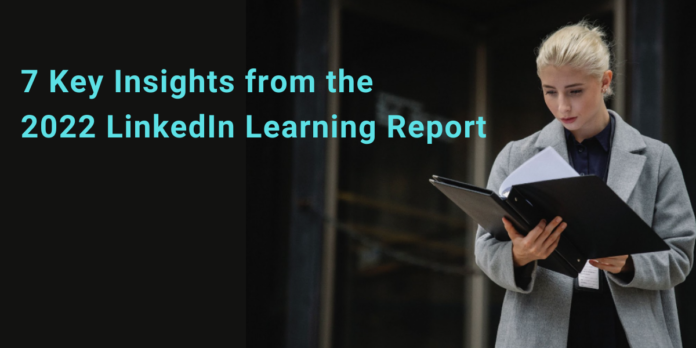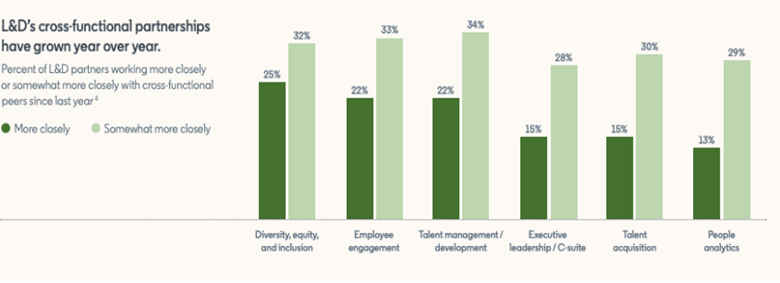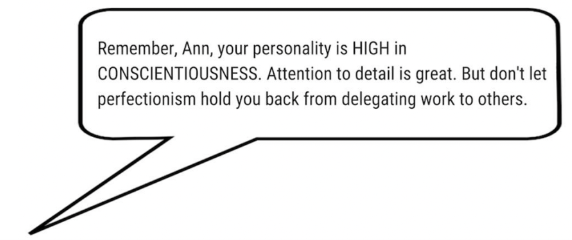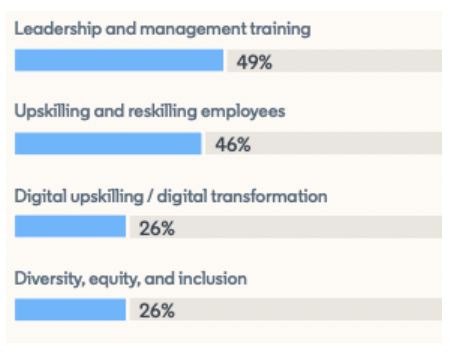
The LinkedIn 2022 Workplace Report is out, entitled “The Transformation of L&D.”
The report draws on a blend of data and interviews with L&D leaders to lay out the current state of L&D. Going through the report, it’s no surprise to see that the L&D landscape has shifted as a result of the disruption and change of COVID-19. That said, it is surprising to see how the landscape has shifted.
 What follows are 7 key insights from the report into how the L&D landscape is shifting and what L&D pros should do to make the most of these changes.
What follows are 7 key insights from the report into how the L&D landscape is shifting and what L&D pros should do to make the most of these changes.
L&D Pros Are Finally Earning a Seat at the Table.
The way L&D pros responded to COVID-19 and helped their organizations adapt has earned them a seat at the table. Here are some key findings:
- 87% of learning leaders say they had “some to a great deal” of involvement in helping their organization adapt to change.
- The number of L&D pros who agree they “have a seat at the table” increased from less than a quarter to over half.
- Demand for L&D Specialists increased 94%, and L&D pros saw a 15% increase in promotions.
- Nearly half of all L&D pros say their budgets will increase this year.
The question is: What will L&D pros do with their hard-earned and long-awaited seat at the table? Will they take the momentum and build dream programs that revolutionize engagement? Or, will they squander the opportunity on a long list of “key skills” that ultimately don’t push the bar forward enough?
For the 47% of L&D pros who haven’t established a seat yet, the question is: What should they do to catch up?
The next six insights should help shed some light on both of these questions…
L&D Is Forging More Cross-Departmental Relationships to Increase Impact.
L&D pros are reporting greater alignment with business skills than ever before. To achieve this alignment, L&D pros are partnering with other departments. For example, L&D pros report growing partnerships with executive leadership, with DEI, and with people analytics.
Collaboration across departments enables L&D pros to build their goals and training to meet the specific business goals of those departments. It also allows them to tap into the specific expertise of those groups to create better programs. These partnerships are mutually beneficial, and L&D pros should strategize around how they can continue to grow, sustain, and deepen their relationships across their organization.
 Measurement Is Increasingly Part of the Plan, Not an Afterthought or a “Proof.”
Measurement Is Increasingly Part of the Plan, Not an Afterthought or a “Proof.”
“Our top opportunity is to quantify the impact and ensure it is enterprise-wide so that learning can help lead the way forward.” – Sean Hudson VP, Digital and Global Head of L&D, Pfizer
Measurement is increasingly becoming a part of the initial training plan. Often, measurement even helps build the plan.
In the report, Dr. Serena Huang, the Head of People Analytics at Paypal, lays out three tips for L&D pros to consider as they collaborate with People Analytics. First, she recommends setting up measurement early on. That way you can measure the right behaviors and outcomes, and People Analytics can help you improve your program design to assess for and achieve those outcomes. Second, Dr. Huang recommends setting up experiments to see what works. For example, you could look at how successful a program is in-person versus remotely. Lastly, she recommends building out nudges (encouraging reminders) that prompt learning and application long after “class time.”
Employees Want L&D, and They Want it Daily.
With employees leaving jobs at a record-setting pace through the Great Resignation, L&D is increasingly responsible for creating an environment that cultivates employees’ talents and dreams long-term. A big part of delivering on this is making learning a daily part of the employee experience. Amanda Kowal Kenyon, the Chief Employee Experience Officer at Ketchum, is focusing on exactly that:
“We are focusing on how to make Ketchum a long-term, attractive career home, where folks have many opportunities to move up and around into different teams and projects. That starts with embedding learning and skill building in people’s actual day-to-day experiences.”
This opportunity to learn constantly, and in a way that’s flexible to the needs of individual employees, has become more than “nice to have.” It’s an expectation, and many talented employees look elsewhere without it.
L&D Pros Are Leveraging Nudges to Personalize, Measure, and Increase the Frequency of Their Learning
“Use nudges. Consider working with organizational psychologists to design nudges (encouraging reminders) that prompt learning. Design tests to find out which nudges are most effective.” – Dr. Serena Huang, Head of People Analytics at Paypal
When you consider that employees want daily, flexible learning and that L&D pros want a simple way to boost behavior change, nudges are the natural answer. They do both. Nudges can be used to tell employees how to apply past learnings or to provide quick follow-up learnings that help make key ideas stick.
 Leadership Development is the Top Priority in L&D Right Now.
Leadership Development is the Top Priority in L&D Right Now.
Leadership development is the number one priority right now for L&D pros around the world:
 That’s because leaders have such a powerful impact on employee engagement and retainment. At companies that struggle with manager care, employees are nearly 50% more likely to apply for a new job. On the other hand, employees who feel their managers care are three times as likely to report being happy at work and nearly four times as likely to recommend their company to a friend.
That’s because leaders have such a powerful impact on employee engagement and retainment. At companies that struggle with manager care, employees are nearly 50% more likely to apply for a new job. On the other hand, employees who feel their managers care are three times as likely to report being happy at work and nearly four times as likely to recommend their company to a friend.
L&D Pros Are Adopting New Tools to Facilitate Daily Learning.
The natural result of employees wanting constant opportunity for learning and development is the adoption of tools that expand far beyond an LMS. Learners need tools that are flexible with their schedules, their needs, and their styles of learning. Educational technology has boomed through COVID-19 and is expected to more than double in size over the next six years. A big part of this is organizations leveraging tools that support workplace learning. According to the report, three of the most impactful types of tools that have risen to the surface are:
- Personalized learning content.
- Nudges around learning and behaviors.
- Online peer learning networks.
Applying These Insights at Your Organization
Change often becomes a catalyst for innovation and improvement, especially when you take the time to reflect on it. Take some time to reflect on the 9 takeaways above and how they apply to you and your team.






